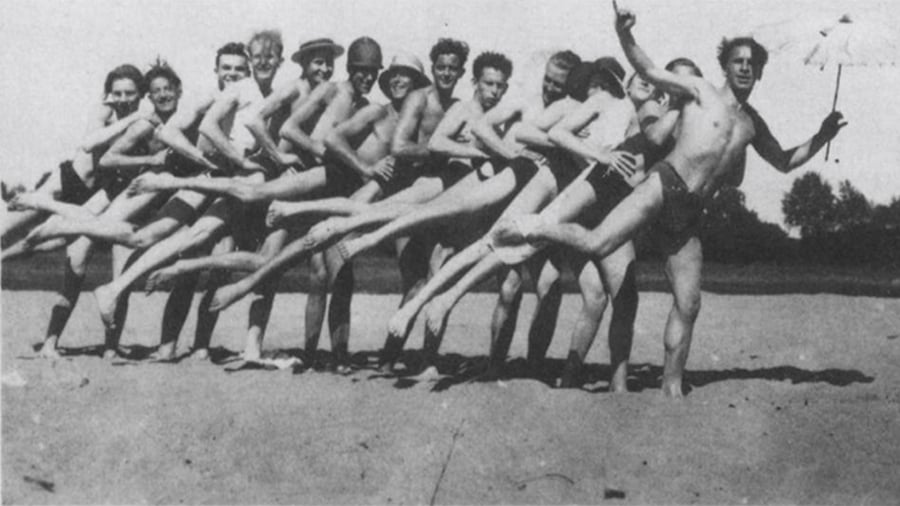
October 21, 2019
Far from Being a Temple to Rationality, the Bauhaus Was a “Cauldron of Perversions”
Architectural historian Beatriz Colomina explores how the Bauhaus harbored deeply transgressive ideas and pedagogies.

© Thomas Breuer/Courtesy Peter McMahon; Barry Bergdoll and Leah Dickerman, pp. 47, Bauhaus 1919-1933: Workshops for Modernity, The Museum of Modern Art, 2009
Editor’s Note: This article by Princeton University School of Architecture professor Beatriz Colomina builds off research on the Bauhaus she and her students began in Spring 2018, which included a catalog, workshop, and a performance produced for the Floating University in Berlin that summer.
Despite its surface rhetoric of rationality, clarity and efficiency, and smooth surfaces, the Bauhaus was never straightforward. Bauhauslers were engaged with everything that escapes rationality: sexuality, violence, esoteric philosophies, occultism, disease, the psyche, pharmacology, extraterrestrial life, artificial intelligence, chance, the primitive, the fetish, the animal, plants, etc. The Bauhaus was in fact a veritable cauldron of perversions.
Modern architecture is usually understood as having a normalizing function, establishing patterns that are stable, predictable, and to some extent standardized. The idea of architecture is intimately associated with the idea of the normal—perhaps it even sees itself as the caretaker of the normal. But the normal is not normal. It is a construction. There is a hidden tradition in architecture of the transgressive, work that crosses the lines of the normal, complicating these lines, threatening the limit.
Take Le Corbusier, for example, arguably the single most influential architect of the 20th century. He was deeply into the occult, esoteric philosophies, sexual complexities, cross-dressing, scatology; he was also obsessed with the toilet, disease, nudism, body building, the animal, and the other. For less well-known figures like Carlo Mollino, architecture and design were literally a product of perversion, so much so he is not easily placed in any traditional account of Modern architecture. Historians don’t know how to position him. So if you take these two extremes—Le Corbusier is a seemingly straight architect who is secretly twisted, and Mollino a seemingly twisted architect that is secretly at the center of Modern architecture—the question is whether so-called perversions are twists of architecture or its very engine.
Perversion comes from the Latin pervertere, “to turn away,” that is, turning away from normality. There is a relationship between the personal, often extreme, pathologies of Modern architecture and the call for a new normal.
If there is no such a thing as Modern architecture without transgression, what is remarkable about the Bauhaus, and perhaps the secret of its success, is the sheer density of transgressions of every kind. It was like a laboratory for inventing and intensifying perversions as a kind of pedagogical strategy. I am reclaiming here the terms “perversion” from its pejorative use to a positive one, in the same way that the label “queer” was reclaimed in the 1980s by gay activists. In fact, inspired by my students at Princeton, I would like to make a call for a queering not just of the Bauhaus but of architectural history, starting with the way we read Modern architecture—what we see or choose not to see.
Purging

© 2019 Artists Rights Society (ARS), New York / c/o Pictoright Amsterdam / Photo: Bauhaus-Archiv Berlin
In his preparatory course at the Bauhaus, Johannes Itten introduced a regime of purging, following the principles of Mazdaznan religion. The idea was to rid the body of “gross matter” through enemas; fasting for three weeks; eating a diet of garlic-based mush; and using machines for pricking the skin. As Paul Citroen, one of the students, put it: “There was, among other things, a little needle machine with which we were to puncture our skins. Then the body would be rubbed with the same sharp oil which had served as a laxative. A few days later all the pinpoints would break out in scabs and pustules—the oil had drawn the wastes and impurities of the deeper skin layers to the surface. Now we were ready to be bandaged, but we must work hard, sweat, and then, with continued fasting, the ulcerations would dry out.”
One of the intended effects of Itten’s regime was a trance-like delirium offering access to spiritual domain—reinforced by deep breathing and concentration exercises ran by Gertrud Grunow. Many of the masters, like Paul Klee and Wassily Kandinsky, were into different forms of occultism and spirituality. Esoteric logic was not esoteric within the school. It was a kind of science. There was even a genre of spirit photography: Bauhaus objects were suspended in a cloud of ghosts (see top image).
Gender Ambiguity

Courtesy Elizabeth Otto, pp. 192, Chapter 9 of Designing Men: New Visions of Masculinity in the Photomontages of Herbert Bayer, Marcel Breuer, and László Moholy-Nagy, Routledge, 2013
There was continuous experimentation with the performance of gender at the Bauhaus. Gender inversion was the norm. Famously, women performed as men. Less famously, men cross-dressed, putting on lipstick and tights. Marcel Breuer sent a tantalizing card to Walter Gropius for his 41st birthday party including a double image of himself as a woman with the words: “My dear Walter, keep our sweet secret. Eternally and truly yours.”
Hair

Courtesy John Cooper
The Bauhaus is unthinkable without the haircuts, which were used to embrace gender ambiguity, express modernity, and convey an otherworldliness. The Bauhaus student had to look like a Bauhaus student, which meant visualizing transgression (see bottom image). One can do a catalog of all the Bauhaus haircuts and their evolution, including completely shaving your head as Itten urged his followers.
Leather

Photograph by Umbo (Otto Umbehr). © 2019 Phyllis Umbehr/Galerie Kicken Berlin / Artists Rights Society (ARS), New York / VG Bild-Kunst, Bonn / Photo: Mercedes Valdivieso, pp. 95, La Bauhaus de festa, Fundació la Caixa, 2005
The leather of Luftwaffe jackets used by fighter pilots and Berlin’s S&M and lesbian clubs made its way into the Bauhaus as a symbol of cultural rebellion and sensuality in clothes, both male and female. Chairs bound like corsets and leather straps lying around inexplicably in photographs suggest something illicit.
Eroticism

Courtesy Bauhaus-Archiv Berlin
For all the official commitment to artistic experimentation on the way towards sober industrial design—there is a continuous erotic charge. The beach, for example, was never simply the beach. It was yet another space of transgression and intimacy between teachers, between teacher and student, and within genders. Naked bodies smoldering in the sun are tenderly photographed. Fourteen scantily clad men happily hold each other intimately while performing a kind of feminized cabaret, complete with delicately raised legs and a parasol.
The Affairs

Courtesy Bauhaus-Archiv Berlin
Lotte Beese, later the chief architect in charge of the massive reconstruction of bombed-out Rotterdam after the war, was the first female Bauhaus student allowed in the architecture workshop started by Hannes Meyer in 1927. Meyer had an affair with Beese while he was married with children. When he became director, Beese was asked to leave the Bauhaus because it wouldn’t look good. Walter Gropius had a sexual relationship with a student who was a war widow while he was still married to Alma Mahler and with a mistress, Lily Hildebrandt.
Sweatshop

Photograph by Walter Hege. © 2019 Artists Rights Society (ARS), New York / VG Bild-Kunst, Bonn; Courtesy Bauhaus-Archiv Berlin
After the preliminary course, all women were sent to the weaving workshop whether they liked it or not. Since weaving made the greatest profits for the Bauhaus, we could ask whether it was a workshop or a sweatshop. Women sustained the Bauhaus but were diminished within it. It was a transgressive school in many ways, but not in gender politics. Gropius even theorized his discrimination in his inaugural lecture. The artistic impulse was that of a man who has experienced the horror of war rather than the “dearest ladies” who remained at home: “…the awakening of the whole man through trauma, lack, terror, hard life experience of love leads to authentic artistic expression. Dearest ladies, I do not underestimate the human achievement of those who remained at home during the war, but I believe that the lived experience of death to be all-powerful.”
You may also enjoy “RIBA Exhibition Tells the Oft-Neglected Story of the ‘British Bauhaus’.”
Would you like to comment on this article? Send your thoughts to: [email protected]







